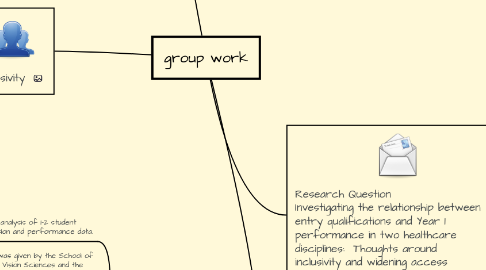
1. McCaig and Adnett (2009) OPTOM – recruiting ethos. PHYSIO – selecting ethos.
2. Ideas
2.1. Investigate student performance for 2 courses with differing recruitment agendas
3. Inclusivity
3.1. Sociologists have regarded education as a paradox for many years (Thomas 1990).
3.2. The Schwartz report (2004) recommended ‘a need for a fair admissions system is one that provides equal opportunity for all individuals. Regardless of background, to gain admission to a course suited to their ability and aspirations’
3.3. 2011 Higher Education white paper for England encouraged use of contextual data.
3.4. HEFWC sets out commitment to widening access.
4. Research Design
4.1. Retrospective analysis of 1-2 student cohorts admission and performance data.
4.2. Ethic approval was given by the School of Optomology and Vision Sciences and the projects were discussed with learning and teaching lead (OPTOM) and director of undergraduate studies (PHYSIO).
4.3. Data collected was from a convenience sample of students from the last 1-2 years depending on school, no recruitment as data already held on SIMS.
4.4. Data was entered anonymously into an electronic database. This included; entry qualifications (grades and subjects), first year and prelim year assessment performance for all modules, MMI scores, nationality of students and contextual status.
4.5. Students entry qualifications were categorised into 3 groups, traditional qualifications, non-traditional qualifications and traditional qualifications not attained entry requirements.
5. Research Question Investigating the relationship between entry qualifications and Year 1 performance in two healthcare disciplines: Thoughts around inclusivity and widening access related to student recruitment and assessment.
5.1. In a political environment of widening access and competition for students is their evidence that students with different entry qualifications do better or worse than others.
5.1.1. Much debate
5.1.2. Cantwell et al (2001), students entering via non-traditional routes demonstrate marginally lower academic performance (?standardised for age)
5.1.3. Brimble (2015) standardising qualifications based on UCAS points found no real difference between non-traditional and tradition routes for nursing students. Green and Waterfield (1997) reported similar findings in physiotherapy.
5.1.4. McCarey et al (2007) reported younger students with non-conventional qualifications were least successful academically suggesting an effect for age.
5.2. Do we have evidence that supports set course entry qualifications based on traditions or course approach to student recruitment.
5.2.1. Reasonable evidence that there is an association between entry grades and student performance (McCarey et 2007, Hoare and Johnston 2010, Wambugu and emeke 2013)
5.2.2. Students from less advantaged backgrounds are under-represented, partly because their prior qualifications are lower than average (bolivar et al 2015).
5.2.3. Growing recognition that that prior qualifications do not always give an adequate indication of student ‘potential’ and that qualifications should be contextualised especially with the presence in society of educational disadvantage.
5.3. What has been the effect of widening access strategies i.e. Prelim year in OPTOM, MMIs in PHYSIO and use of contextual data.
5.3.1. Multiple mini interviews (MMIs)
5.3.2. Preliminary year
5.4. Do any factors help predict student performance and is there evidence that there is fairness for all students to progress to their potential, especially around failure of modules and student progression across all performance levels.
5.4.1. Payton (1997) in met-analysis of admission criteria for physiotherapy education that grade point average/pre-entry academic grade average was a valid and reliable predictor of student success for academic portion.
5.4.2. Support by two other studies looking across subjects, Croxford (2013) in Edinburgh and, Hoare and Johnston (2010) in Bristol.
5.4.3. Morris and Farmer (1997) contradicted this writing that academic grades were a weak predictor of course performance across the 3 years.
5.4.4. Other characteristics strongly associated with attainment was gender and Ethnicity (Hoare and Johnston 2010) and age (Cantwell et al. 2001)
